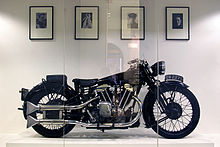Imperial War Museum
The Imperial War Museum ( English for Imperial or Imperial War Museum ) in London is one of the most important war museums in the world.
history
The Imperial War Museum was founded during the First World War on the initiative of private individuals, including the industrialist Alfred Moritz Mond , the writer Sir William Martin Conway and the curator of the arms collection in the Tower of London , Charles ffoulkes . The British government saw the planned museum primarily as an opportunity for propaganda and supported the work financially.
In 1917 the museum committee collected material with the help of the British embassies in friendly and neutral foreign countries and with the help of private individuals. Conway went personally to France to secure items that were no longer needed for the museum.
In the Tower of London there was no place, also they wanted to take of modern warfare in the collection in the Royal Armories no artifacts. The Imperial War Museum first had its location in Crystal Palace , then in the Science Museum and finally in Lambeth .
From the beginning, the plans went beyond a pure military museum. It should be shown how the war affects people of all social classes in all countries of the Empire. The first exhibitions then also dealt with the work of the Red Cross or women's work in war. In addition, the war propaganda office commissioned some artists to document everyday war life directly at the front. These included the painters William Orpen , Paul Nash , Muirhead Bone and Wyndham Lewis . Today the museum owns over 15,000 paintings, drawings and sculptures.
present
The museum is primarily concerned with the two world wars . In addition to the exhibition of weapons, vehicles and other technical equipment in the atrium of the house, one floor is dedicated to the military and cultural history of both wars. It is less documents or photos that are shown than uniforms, everyday objects and the like. The Holocaust , about which a separate exhibition has been created, is of outstanding importance in the museum . Further sections deal with other wars of the 20th century in which British soldiers were involved. In addition, temporary exhibitions are organized on a regular basis.
The museum designs its exhibitions from the perspective of the British military and British society. This is expressed, for example, in the display of captured military equipment, the intensive preoccupation with the bombing of London by the German air force in World War II or the western interpretation of the East-West conflict .
In autumn 2012, on the occasion of the upcoming memorial days for the First World War , renovation work began for the equivalent of 50 million euros. Above all, the museum completely redesigned the First World War Galleries , with Prince William opening the new exhibition rooms on July 17, 2014 .
Branch offices
There is a branch in Manchester called the Imperial War Museum North . It was designed by the architect Daniel Libeskind .
The museum ship HMS Belfast in London as well as the Cabinet War Rooms and the Churchill Museum also belong to the Imperial War Museum.
Aircraft displays at the Imperial War Museum Duxford near Cambridge .
Exhibits
(Selection)
Imperial eagle of the Reich Chancellery
P-51 Mustang before restyling
Painting of the burning HMS Dunraven in 1917 by Charles Pears
There are also a V1 and a V2 on display, the engine of the Fokker Dr.1 by Manfred von Richthofen , and the windshield of the Royal Aircraft Factory SE5. by British fighter pilot James McCudden .
See also
literature
- Peter Simkins : The Imperial War Museum in London and its depiction of the war, 1917–1995 . In: Hans-Martin Hinz (ed.): The war and its museums . For the German Historical Museum , Campus, Frankfurt am Main a. a. 1997, ISBN 3-593-35838-7 , pp. 27 ff.
- Paul Cornish: The First World War Galleries . Imperial War Museum, London 2014. ISBN 978-1-904897-86-6
Web links
- Imperial War Museum (English)
- Schwinghammer, Uwe: Military museums: The Imperial War Museum in London , from: Troop service , episode 312, issue 6/2009
Individual evidence
- ↑ http://www.1914.org/news/100-years-of-imperial-war-museums/
- ↑ https://web.archive.org/web/20130704104132/http://www.royalarmouries.org/about-us/brief-museum-history/history-of-the-collection/early-scholars/charles-john -Foulkes Royal Armories via Charles ffoulkes
- ^ Prince William : Foreword . In: Paul Cornish: The First World War Galleries . Imperial War Museum, London 2014. ISBN 978-1-904897-86-6 , p. 7
- ^ Military man Prince William opens the Imperial War Museum's new WW1 galleries www.express.co.uk
Coordinates: 51 ° 29 ′ 45 ″ N , 0 ° 6 ′ 30 ″ W.








